Strategic Management Assignment: Porter's Strategies and IKEA
VerifiedAdded on 2022/08/23
|7
|1465
|37
Report
AI Summary
This report provides a comprehensive analysis of IKEA's strategic management, focusing on Porter's generic strategies and the Strategy Clock model. It begins by defining and differentiating Porter's three generic strategies: cost leadership, differentiation, and focus. The report then introduces the Bowman's Strategy Clock, highlighting its eight strategic positions based on perceived value and price. It compares and contrasts these two models, emphasizing the Strategy Clock's broader applicability. Part B applies the Strategy Clock model to IKEA, concluding that IKEA uses a hybrid strategy combining cost leadership and differentiation. The report examines how this hybrid strategy allows IKEA to offer high-value products at low costs, leading to a strong customer base, market share, and competitive advantage. Recommendations are made for IKEA to maintain its strategic position through innovation, strong managerial control, and product differentiation to compete with international players. The report references key academic sources to support its analysis.
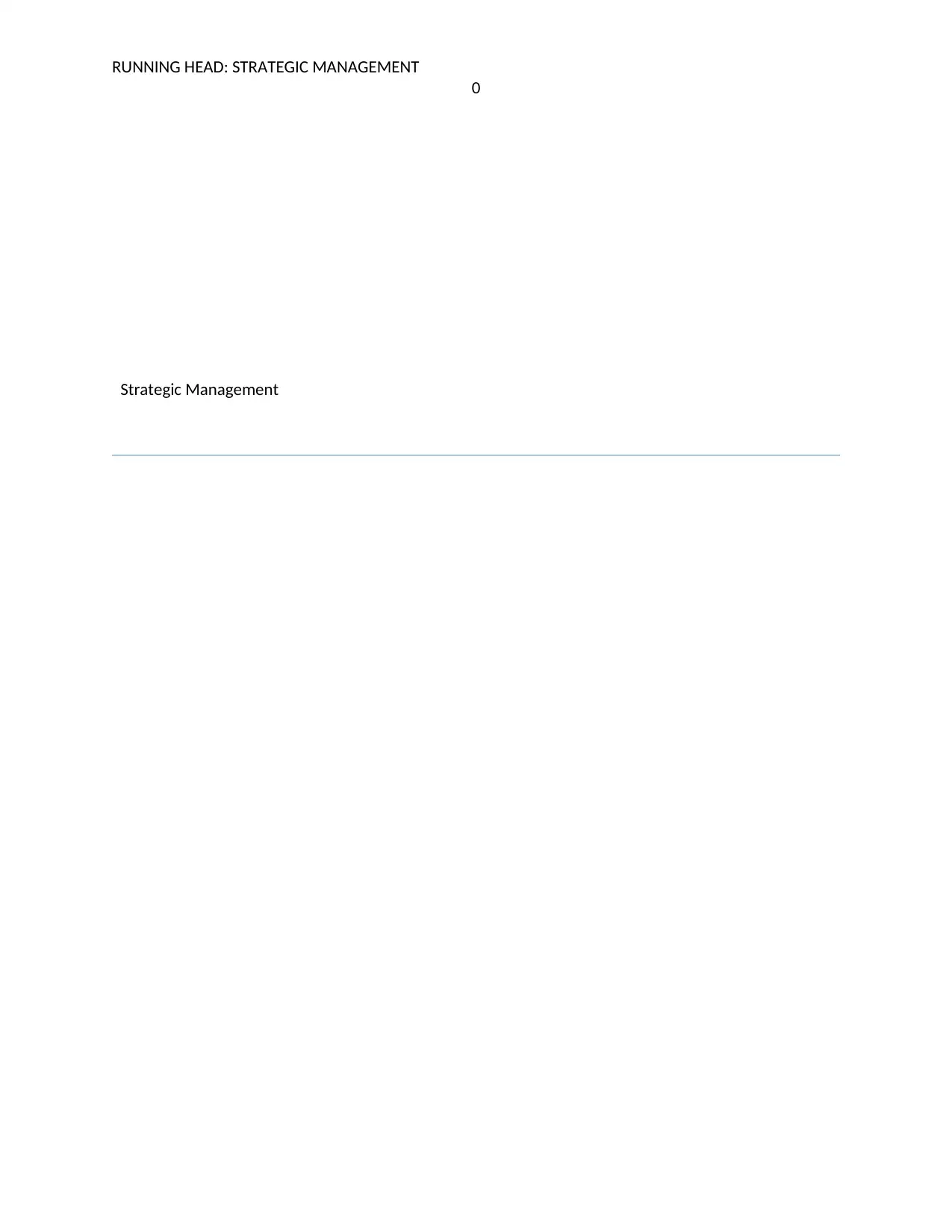
RUNNING HEAD: STRATEGIC MANAGEMENT
0
Strategic Management
0
Strategic Management
Paraphrase This Document
Need a fresh take? Get an instant paraphrase of this document with our AI Paraphraser

Strategic Management
1
Part A
Porter’s Generic Strategies
Porter generic strategies define how a company pursues competitive advantage across its target
market. There are three strategies that are given under this framework that includes cost
leadership strategy, differentiation strategy and focus strategy. A company use one of these
strategies for getting competitive advantage that includes getting advantage via lowering the
costs, or by differentiating valued by customers to command a higher price (Cavaleri and
Shabana,2018).
Cost leadership strategy: This strategy focus on the cost concern of products, this include
lowering cost of products in comparison to other competitors. The competitive advantage with
this strategy can be achieved by offering the lowest prices to the target customers. The
companies can lower its cost by focusing on controlling the indirect and direct operating costs
and on the other side control over value chain helps in reducing the cost of production with that
companies gain competitive advantage (Johnson,2016).
Differentiation strategy: This strategy includes differentiation of services and products in a
way that help in to create a unique value proposition this leads to a competitive advantage. This
strategy is used by companies whose target markets are not price concern and appreciate
innovation and premium products. This strategy is mainly used by big organizations in order to
compete in the market (Viltard,2017).
1
Part A
Porter’s Generic Strategies
Porter generic strategies define how a company pursues competitive advantage across its target
market. There are three strategies that are given under this framework that includes cost
leadership strategy, differentiation strategy and focus strategy. A company use one of these
strategies for getting competitive advantage that includes getting advantage via lowering the
costs, or by differentiating valued by customers to command a higher price (Cavaleri and
Shabana,2018).
Cost leadership strategy: This strategy focus on the cost concern of products, this include
lowering cost of products in comparison to other competitors. The competitive advantage with
this strategy can be achieved by offering the lowest prices to the target customers. The
companies can lower its cost by focusing on controlling the indirect and direct operating costs
and on the other side control over value chain helps in reducing the cost of production with that
companies gain competitive advantage (Johnson,2016).
Differentiation strategy: This strategy includes differentiation of services and products in a
way that help in to create a unique value proposition this leads to a competitive advantage. This
strategy is used by companies whose target markets are not price concern and appreciate
innovation and premium products. This strategy is mainly used by big organizations in order to
compete in the market (Viltard,2017).
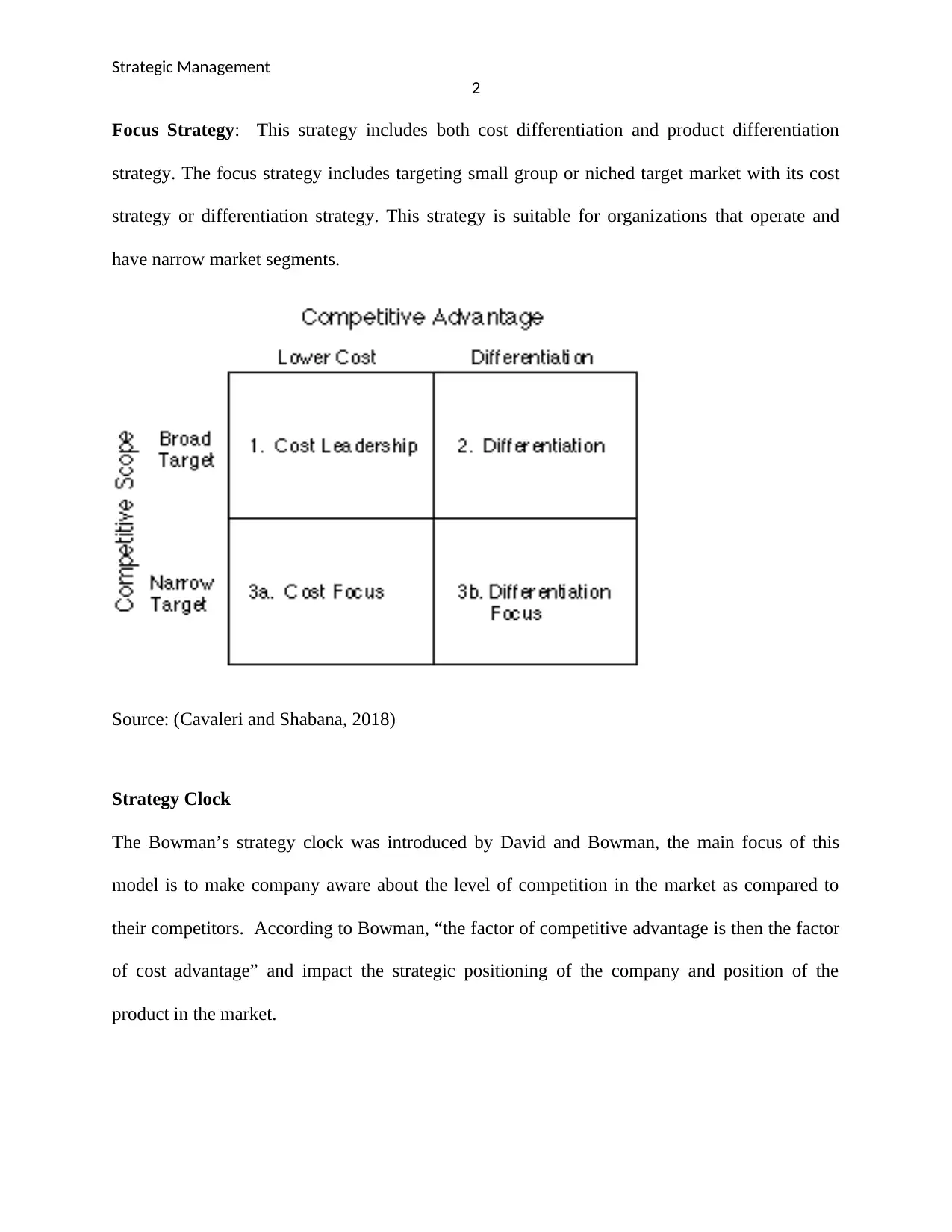
Strategic Management
2
Focus Strategy: This strategy includes both cost differentiation and product differentiation
strategy. The focus strategy includes targeting small group or niched target market with its cost
strategy or differentiation strategy. This strategy is suitable for organizations that operate and
have narrow market segments.
Source: (Cavaleri and Shabana, 2018)
Strategy Clock
The Bowman’s strategy clock was introduced by David and Bowman, the main focus of this
model is to make company aware about the level of competition in the market as compared to
their competitors. According to Bowman, “the factor of competitive advantage is then the factor
of cost advantage” and impact the strategic positioning of the company and position of the
product in the market.
2
Focus Strategy: This strategy includes both cost differentiation and product differentiation
strategy. The focus strategy includes targeting small group or niched target market with its cost
strategy or differentiation strategy. This strategy is suitable for organizations that operate and
have narrow market segments.
Source: (Cavaleri and Shabana, 2018)
Strategy Clock
The Bowman’s strategy clock was introduced by David and Bowman, the main focus of this
model is to make company aware about the level of competition in the market as compared to
their competitors. According to Bowman, “the factor of competitive advantage is then the factor
of cost advantage” and impact the strategic positioning of the company and position of the
product in the market.
⊘ This is a preview!⊘
Do you want full access?
Subscribe today to unlock all pages.

Trusted by 1+ million students worldwide
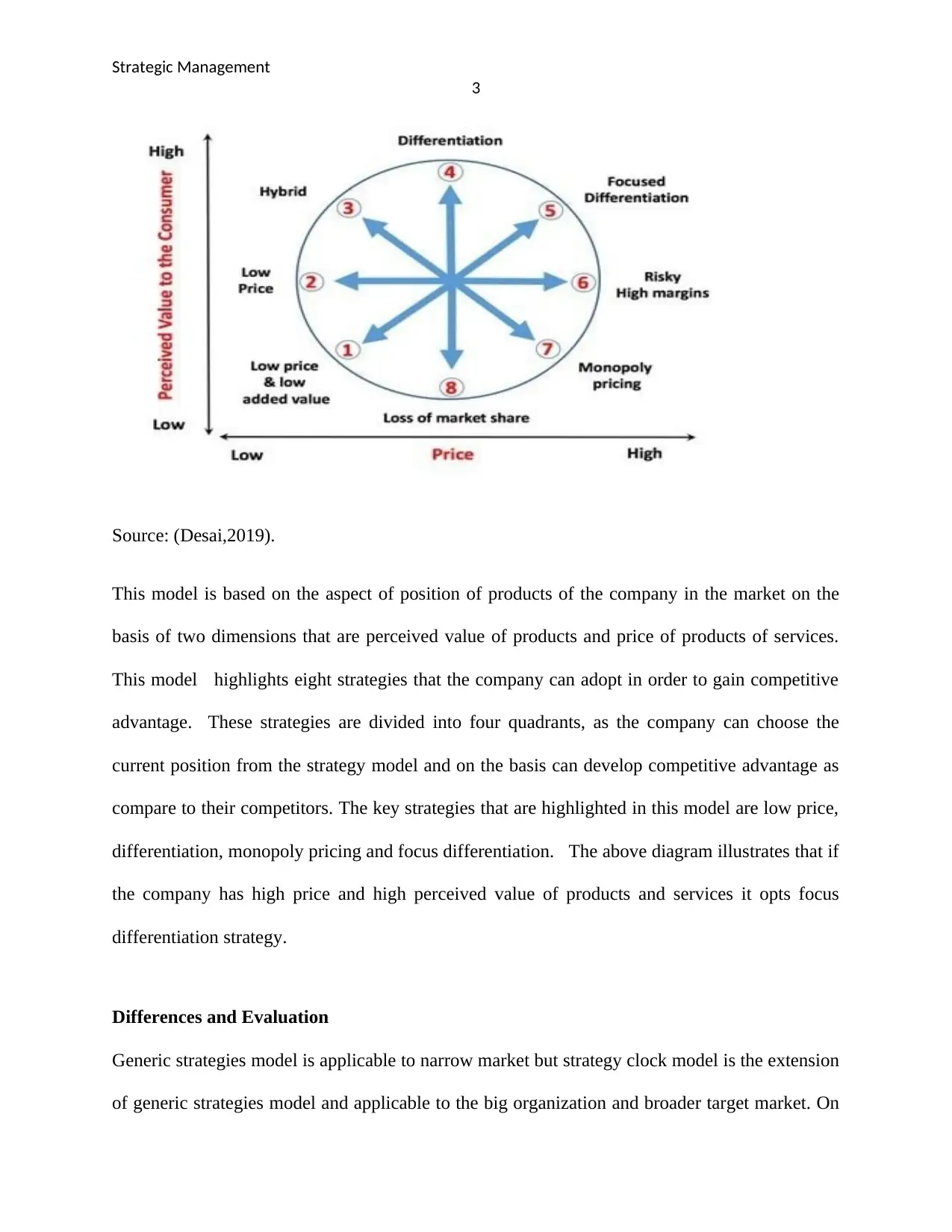
Strategic Management
3
Source: (Desai,2019).
This model is based on the aspect of position of products of the company in the market on the
basis of two dimensions that are perceived value of products and price of products of services.
This model highlights eight strategies that the company can adopt in order to gain competitive
advantage. These strategies are divided into four quadrants, as the company can choose the
current position from the strategy model and on the basis can develop competitive advantage as
compare to their competitors. The key strategies that are highlighted in this model are low price,
differentiation, monopoly pricing and focus differentiation. The above diagram illustrates that if
the company has high price and high perceived value of products and services it opts focus
differentiation strategy.
Differences and Evaluation
Generic strategies model is applicable to narrow market but strategy clock model is the extension
of generic strategies model and applicable to the big organization and broader target market. On
3
Source: (Desai,2019).
This model is based on the aspect of position of products of the company in the market on the
basis of two dimensions that are perceived value of products and price of products of services.
This model highlights eight strategies that the company can adopt in order to gain competitive
advantage. These strategies are divided into four quadrants, as the company can choose the
current position from the strategy model and on the basis can develop competitive advantage as
compare to their competitors. The key strategies that are highlighted in this model are low price,
differentiation, monopoly pricing and focus differentiation. The above diagram illustrates that if
the company has high price and high perceived value of products and services it opts focus
differentiation strategy.
Differences and Evaluation
Generic strategies model is applicable to narrow market but strategy clock model is the extension
of generic strategies model and applicable to the big organization and broader target market. On
Paraphrase This Document
Need a fresh take? Get an instant paraphrase of this document with our AI Paraphraser
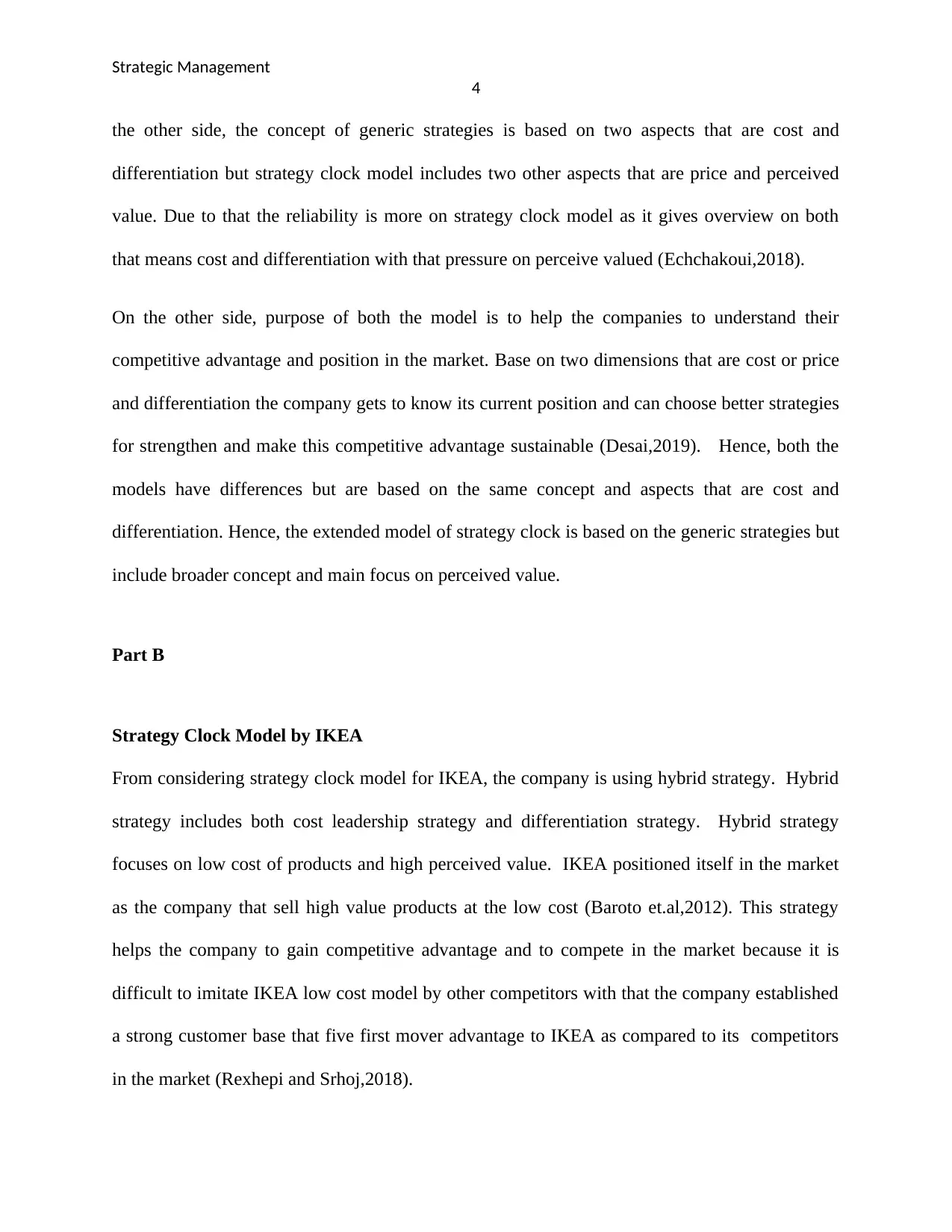
Strategic Management
4
the other side, the concept of generic strategies is based on two aspects that are cost and
differentiation but strategy clock model includes two other aspects that are price and perceived
value. Due to that the reliability is more on strategy clock model as it gives overview on both
that means cost and differentiation with that pressure on perceive valued (Echchakoui,2018).
On the other side, purpose of both the model is to help the companies to understand their
competitive advantage and position in the market. Base on two dimensions that are cost or price
and differentiation the company gets to know its current position and can choose better strategies
for strengthen and make this competitive advantage sustainable (Desai,2019). Hence, both the
models have differences but are based on the same concept and aspects that are cost and
differentiation. Hence, the extended model of strategy clock is based on the generic strategies but
include broader concept and main focus on perceived value.
Part B
Strategy Clock Model by IKEA
From considering strategy clock model for IKEA, the company is using hybrid strategy. Hybrid
strategy includes both cost leadership strategy and differentiation strategy. Hybrid strategy
focuses on low cost of products and high perceived value. IKEA positioned itself in the market
as the company that sell high value products at the low cost (Baroto et.al,2012). This strategy
helps the company to gain competitive advantage and to compete in the market because it is
difficult to imitate IKEA low cost model by other competitors with that the company established
a strong customer base that five first mover advantage to IKEA as compared to its competitors
in the market (Rexhepi and Srhoj,2018).
4
the other side, the concept of generic strategies is based on two aspects that are cost and
differentiation but strategy clock model includes two other aspects that are price and perceived
value. Due to that the reliability is more on strategy clock model as it gives overview on both
that means cost and differentiation with that pressure on perceive valued (Echchakoui,2018).
On the other side, purpose of both the model is to help the companies to understand their
competitive advantage and position in the market. Base on two dimensions that are cost or price
and differentiation the company gets to know its current position and can choose better strategies
for strengthen and make this competitive advantage sustainable (Desai,2019). Hence, both the
models have differences but are based on the same concept and aspects that are cost and
differentiation. Hence, the extended model of strategy clock is based on the generic strategies but
include broader concept and main focus on perceived value.
Part B
Strategy Clock Model by IKEA
From considering strategy clock model for IKEA, the company is using hybrid strategy. Hybrid
strategy includes both cost leadership strategy and differentiation strategy. Hybrid strategy
focuses on low cost of products and high perceived value. IKEA positioned itself in the market
as the company that sell high value products at the low cost (Baroto et.al,2012). This strategy
helps the company to gain competitive advantage and to compete in the market because it is
difficult to imitate IKEA low cost model by other competitors with that the company established
a strong customer base that five first mover advantage to IKEA as compared to its competitors
in the market (Rexhepi and Srhoj,2018).
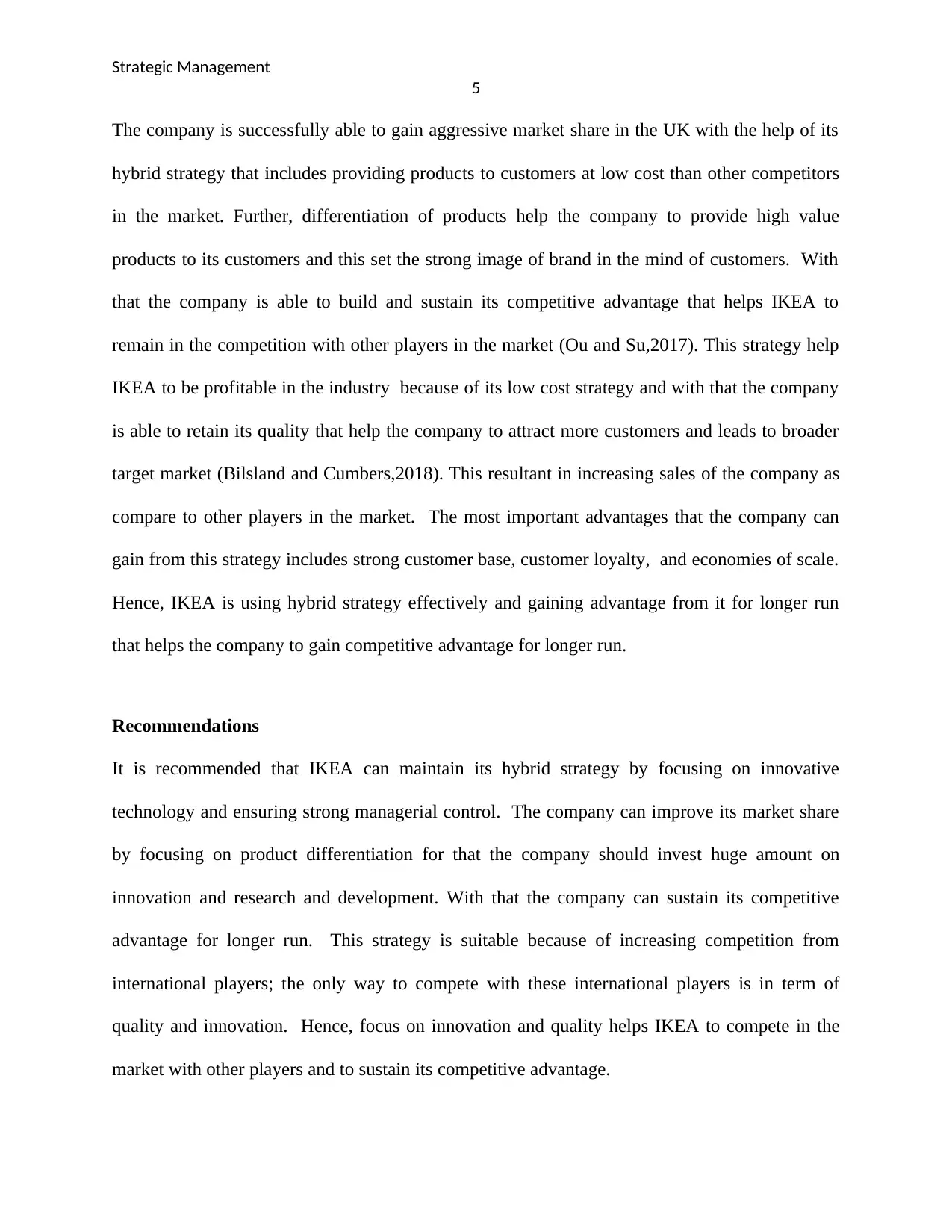
Strategic Management
5
The company is successfully able to gain aggressive market share in the UK with the help of its
hybrid strategy that includes providing products to customers at low cost than other competitors
in the market. Further, differentiation of products help the company to provide high value
products to its customers and this set the strong image of brand in the mind of customers. With
that the company is able to build and sustain its competitive advantage that helps IKEA to
remain in the competition with other players in the market (Ou and Su,2017). This strategy help
IKEA to be profitable in the industry because of its low cost strategy and with that the company
is able to retain its quality that help the company to attract more customers and leads to broader
target market (Bilsland and Cumbers,2018). This resultant in increasing sales of the company as
compare to other players in the market. The most important advantages that the company can
gain from this strategy includes strong customer base, customer loyalty, and economies of scale.
Hence, IKEA is using hybrid strategy effectively and gaining advantage from it for longer run
that helps the company to gain competitive advantage for longer run.
Recommendations
It is recommended that IKEA can maintain its hybrid strategy by focusing on innovative
technology and ensuring strong managerial control. The company can improve its market share
by focusing on product differentiation for that the company should invest huge amount on
innovation and research and development. With that the company can sustain its competitive
advantage for longer run. This strategy is suitable because of increasing competition from
international players; the only way to compete with these international players is in term of
quality and innovation. Hence, focus on innovation and quality helps IKEA to compete in the
market with other players and to sustain its competitive advantage.
5
The company is successfully able to gain aggressive market share in the UK with the help of its
hybrid strategy that includes providing products to customers at low cost than other competitors
in the market. Further, differentiation of products help the company to provide high value
products to its customers and this set the strong image of brand in the mind of customers. With
that the company is able to build and sustain its competitive advantage that helps IKEA to
remain in the competition with other players in the market (Ou and Su,2017). This strategy help
IKEA to be profitable in the industry because of its low cost strategy and with that the company
is able to retain its quality that help the company to attract more customers and leads to broader
target market (Bilsland and Cumbers,2018). This resultant in increasing sales of the company as
compare to other players in the market. The most important advantages that the company can
gain from this strategy includes strong customer base, customer loyalty, and economies of scale.
Hence, IKEA is using hybrid strategy effectively and gaining advantage from it for longer run
that helps the company to gain competitive advantage for longer run.
Recommendations
It is recommended that IKEA can maintain its hybrid strategy by focusing on innovative
technology and ensuring strong managerial control. The company can improve its market share
by focusing on product differentiation for that the company should invest huge amount on
innovation and research and development. With that the company can sustain its competitive
advantage for longer run. This strategy is suitable because of increasing competition from
international players; the only way to compete with these international players is in term of
quality and innovation. Hence, focus on innovation and quality helps IKEA to compete in the
market with other players and to sustain its competitive advantage.
⊘ This is a preview!⊘
Do you want full access?
Subscribe today to unlock all pages.

Trusted by 1+ million students worldwide
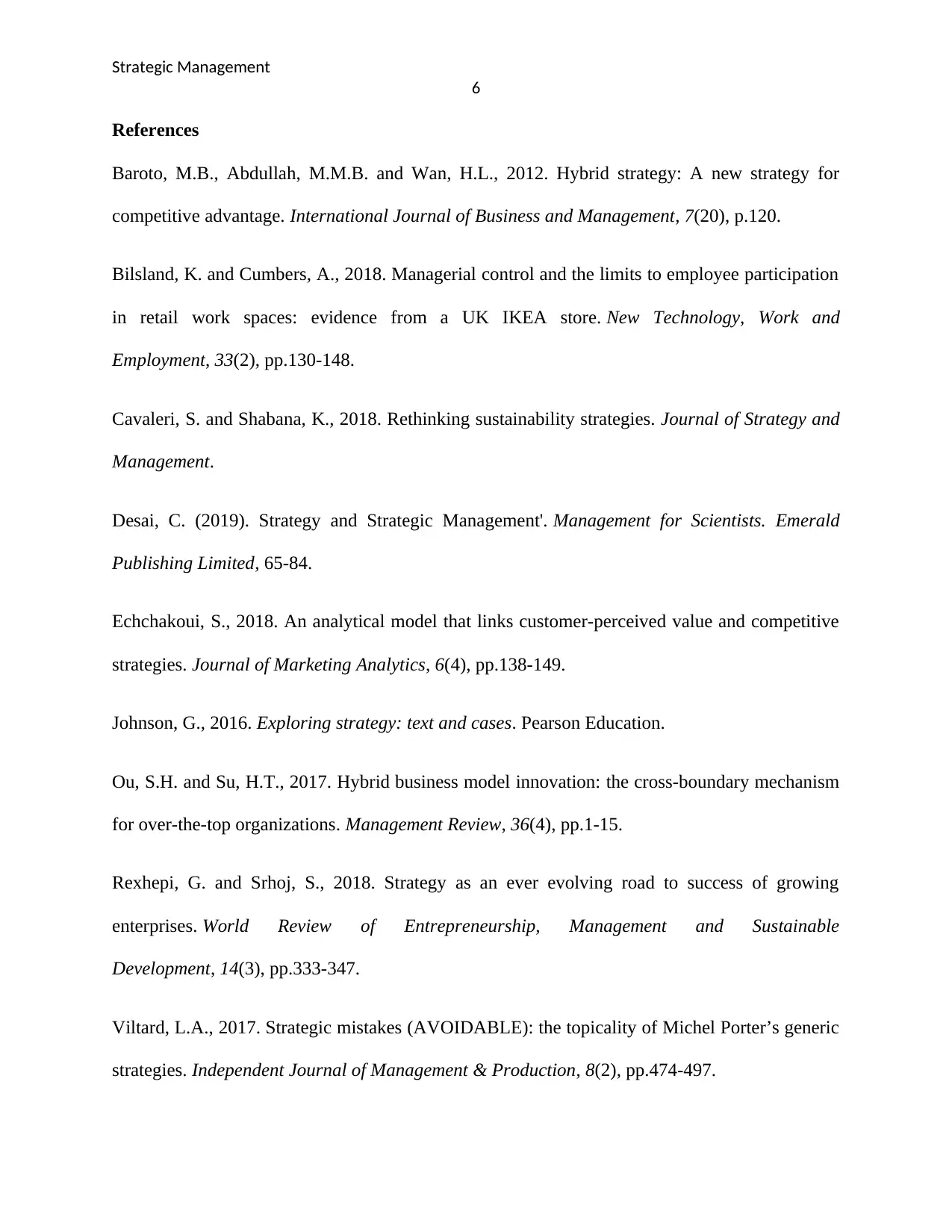
Strategic Management
6
References
Baroto, M.B., Abdullah, M.M.B. and Wan, H.L., 2012. Hybrid strategy: A new strategy for
competitive advantage. International Journal of Business and Management, 7(20), p.120.
Bilsland, K. and Cumbers, A., 2018. Managerial control and the limits to employee participation
in retail work spaces: evidence from a UK IKEA store. New Technology, Work and
Employment, 33(2), pp.130-148.
Cavaleri, S. and Shabana, K., 2018. Rethinking sustainability strategies. Journal of Strategy and
Management.
Desai, C. (2019). Strategy and Strategic Management'. Management for Scientists. Emerald
Publishing Limited, 65-84.
Echchakoui, S., 2018. An analytical model that links customer-perceived value and competitive
strategies. Journal of Marketing Analytics, 6(4), pp.138-149.
Johnson, G., 2016. Exploring strategy: text and cases. Pearson Education.
Ou, S.H. and Su, H.T., 2017. Hybrid business model innovation: the cross-boundary mechanism
for over-the-top organizations. Management Review, 36(4), pp.1-15.
Rexhepi, G. and Srhoj, S., 2018. Strategy as an ever evolving road to success of growing
enterprises. World Review of Entrepreneurship, Management and Sustainable
Development, 14(3), pp.333-347.
Viltard, L.A., 2017. Strategic mistakes (AVOIDABLE): the topicality of Michel Porter’s generic
strategies. Independent Journal of Management & Production, 8(2), pp.474-497.
6
References
Baroto, M.B., Abdullah, M.M.B. and Wan, H.L., 2012. Hybrid strategy: A new strategy for
competitive advantage. International Journal of Business and Management, 7(20), p.120.
Bilsland, K. and Cumbers, A., 2018. Managerial control and the limits to employee participation
in retail work spaces: evidence from a UK IKEA store. New Technology, Work and
Employment, 33(2), pp.130-148.
Cavaleri, S. and Shabana, K., 2018. Rethinking sustainability strategies. Journal of Strategy and
Management.
Desai, C. (2019). Strategy and Strategic Management'. Management for Scientists. Emerald
Publishing Limited, 65-84.
Echchakoui, S., 2018. An analytical model that links customer-perceived value and competitive
strategies. Journal of Marketing Analytics, 6(4), pp.138-149.
Johnson, G., 2016. Exploring strategy: text and cases. Pearson Education.
Ou, S.H. and Su, H.T., 2017. Hybrid business model innovation: the cross-boundary mechanism
for over-the-top organizations. Management Review, 36(4), pp.1-15.
Rexhepi, G. and Srhoj, S., 2018. Strategy as an ever evolving road to success of growing
enterprises. World Review of Entrepreneurship, Management and Sustainable
Development, 14(3), pp.333-347.
Viltard, L.A., 2017. Strategic mistakes (AVOIDABLE): the topicality of Michel Porter’s generic
strategies. Independent Journal of Management & Production, 8(2), pp.474-497.
1 out of 7
Related Documents
Your All-in-One AI-Powered Toolkit for Academic Success.
+13062052269
info@desklib.com
Available 24*7 on WhatsApp / Email
![[object Object]](/_next/static/media/star-bottom.7253800d.svg)
Unlock your academic potential
Copyright © 2020–2025 A2Z Services. All Rights Reserved. Developed and managed by ZUCOL.





